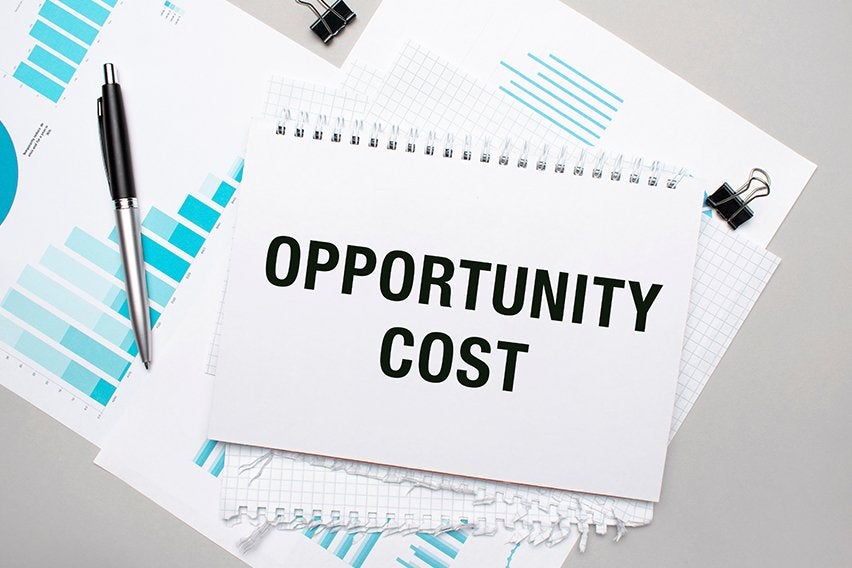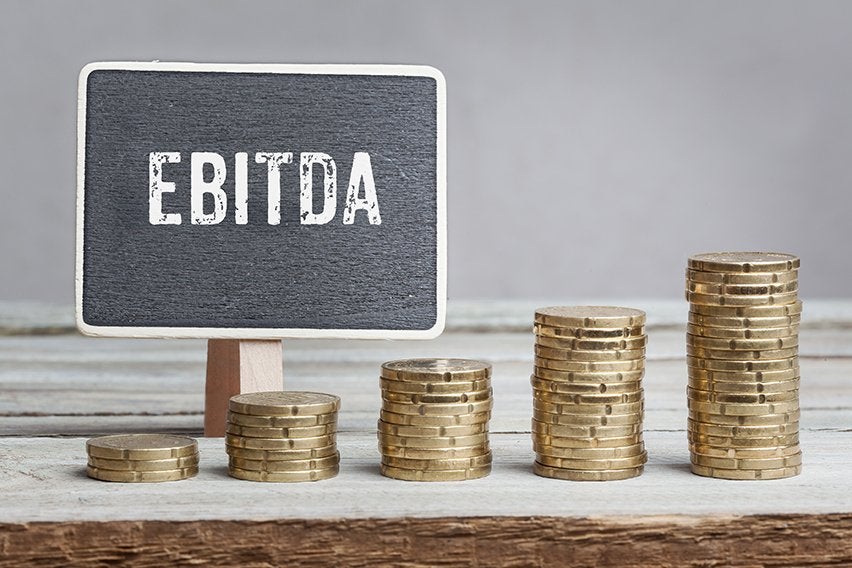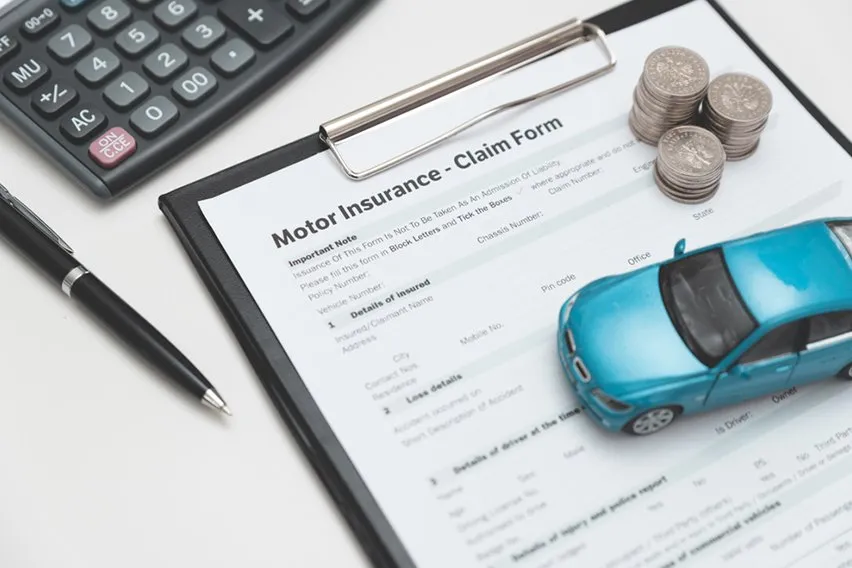What Is Opportunity Cost? Definition & Examples

Do you remember any time when you had to choose between two things? Perhaps you had to choose between cooking dinner for your kids on Sunday afternoon instead of ordering pizza. Or maybe it was studying for your end-of-semester exams instead of binge-watching your favourite movie on Netflix. Now, the choice is selling your stock shares rather than holding on to them for the future.
Every decision you make results in an opportunity cost. This is because every time you opt for one option over another, you miss something else.
An investor’s opportunity cost is the potential profit loss when choosing one investment over another. Selling immediately may secure any immediate gains. However, an investor may give up additional gains the investment might bring in the future.
Find out how you can use opportunity cost to make informed investment decisions. You can also see examples of opportunity cost and get answers to all of your lingering questions.
Here’s What We’ll Cover:
A Simple Definition of Opportunity Cost
Formula and Calculation of Opportunity Cost
What Does It Mean for Individual Investors?
Is Opportunity Cost a Real Cost?
How Does Opportunity Costs Impact You as an Investor?
Opportunity Cost in Monetary Donations
What Is the Opportunity Cost?
The opportunity cost is the cost of losing out in the event you select between two or more choices. In making a decision, you believe that the choice you made will lead to better results for you regardless of what you lose. The opportunity cost of your investment decisions means that you will always experience losses or gains both now and in the future.
Opportunity cost is not an exact measure. However, you can quantify it by estimating what you would have received if you had chosen otherwise. You can also compare the benefits of choosing another option instead.
The concept behind this is intuitive, which is why economists and investors explore it. Think about what would have happened to Walt Disney if he hadn’t started animating?
His name may not have been familiar to you, or he may have gone on to achieve something equally successful. The opportunity cost is like a fork in the road. There are dollar signs on either side of the path. There is something to gain and something to lose by taking each path. Making an informed decision is about estimating the loss associated with each choice.

A Simple Definition of Opportunity Cost
Investors often overlook opportunity costs. Hidden costs are a consequence of not considering alternatives. For instance, a company may not consider the opportunity costs of pursuing one business strategy over another. That’s why it is important to first evaluate the merits of other options.
How Opportunity Cost Works
The concept of opportunity cost is fundamental to the economist’s view of costs. The academic study of economics uses the same opportunity cost formula as we would in everyday practice. The formula is just expressed a little differently.
Economics offers a definition for opportunity cost. It is the difference between the expected return on the forgone investment option (FO) and the selected investment option (CO). More simply put, the formula for opportunity cost is:
Opportunity Cost = Forgone Option – Chosen Option
You can calculate investment returns by totalling the expected returns of each option. Consider, for instance, an exchange-traded fund (ETF) with a 10% return and a rental property with an 8% return. The rental property’s opportunity cost of choosing it is 2%.
Calculating opportunity costs involves considering many factors in addition to flat returns. Also take into consideration the risk involved with each choice.
Generally speaking, the greater the risk of losing money on an investment, the higher the return. It is difficult to compare the opportunity costs of very risky investments to low-risk investments. An example of this is individual stocks (high risk) compared to U.S. Treasury bonds (low risk). Treasuries may seem to have a high opportunity cost on paper. Still, the security they provide might make them preferable in certain situations, such as if you need access to the funds quickly.
Formula and Calculation of Opportunity Cost
Opportunity Cost = FO- CO
FO= Return on best-forgone option
CO= Return on chosen option
Calculating an opportunity cost is as simple as comparing the expected returns of each alternative. Imagine that you have option A, which is to invest in the stock market to earn capital gains. Alternatively, you can reinvest your money back into your business. When you do this, you may anticipate that newer equipment increases production efficiencies. This can lead to lower operating expenses and increased profit margins.
Example 1 of Opportunity Cost
You might carefully weigh the pros and cons of your financial decision before buying an apartment in the city or starting a business. However, most people don’t consider alternative options first.
People often check the balance of their savings account before making a large purchase when they feel cautious. Nevertheless, they don’t always consider the things they must give up when they make those spending decisions.
However, it is possible to miss many opportunities if you buy one cheeseburger every day for 25 years. At a basic level, you miss the opportunity to improve your health. At the same time, spending $4.50 on a burger over 25 years amounts to more than $52,000 if you invested the money instead. This is assuming a 5% return on investment as an alternative.
The core message here applies to a wide range of situations, although this is a simple example. Whenever you buy candy or go on vacation, you probably don’t think about opportunity costs enough. All decisions, whether big or small, come with opportunity costs.
Example 2 of Opportunity Cost
One investor’s parents taught them to always invest their disposable income entirely in bonds at the age of 18. Investing $5,000 per year in bonds, this investor earned an average annual return of 2.50% during the next 50 years and retired with nearly $500,000. At first glance, this result seems impressive. But what is the alternative? The result is not as impressive when considering the investor’s opportunity cost. The value of their portfolio would have exceeded $1 million if they invested half of their savings in the stock market. This is assuming an average blended return of 5%.
What Does It Mean for Individual Investors?
When assessing the potential profitability of various investments, businesses look for the option that is likely to yield the greatest return. Often, they can determine this by looking at the expected rate of return (RoR) for an investment vehicle. However, businesses must also consider the opportunity cost of each alternative option.
It might be difficult to grasp the premise, but the chances are that practically every decision involves some tradeoff. A finite world allows you to be in only one place at a time.
Explicit Costs
An explicit cost is a direct cost or expense investors make out of their own pockets. Examples include stocks, options, or improvements to a rental property. In addition, expenses can include salaries, utilities, materials, and rent.
You pay $30 in labour, ingredients, electricity, and water for a new item added to the menu at your restaurant. Your direct cost is $30.
In other words, the opportunity cost is what you could have done with that $30 if you had not added the new item to the menu. You could have donated $30 to charity. You could have spent it on clothing for yourself. You could have saved it in your retirement account and earned interest on it.
Implicit Costs
An implicit cost is not a financial payment. You may not be directly impacted by these costs, but rather your resources may be deprived of the chance to generate income.
Another example is a second home you use for vacations. The implicit cost is the amount of rental income you could generate by leasing the property when it is not in use. Using the vacation home yourself does not cost you anything. But you do give up the opportunity to make money on the property by not leasing it.
Is Opportunity Cost a Real Cost?
Financial statements do not reflect opportunity costs directly. Despite this, opportunity costs remain a high economic cost. Opportunity cost is an abstract concept. Many companies, executives, and investors fail to consider opportunity cost in everyday decisions.
How Does Opportunity Costs Impact You as an Investor?
Opportunity cost is an inherent driver of investment decisions. The number of options may seem daunting once you understand the opportunity cost. Choosing the wrong investment option means you incur the wrong opportunity costs. You want to avoid making the wrong decision and spending more. But how?
You can mitigate the uncertainty of one asset or asset class doing very well or very poorly over time. Strategically construct your portfolio and outline rules for the percentage of each asset you should hold. As a result, decisions become simpler. You look at each asset class individually and decide how much each holds.
result, decisions
Your investment timeline and risk preference usually dictate asset allocation. With a shorter timeline, you’re likely to want to invest in more conservative investments, such as bonds and bond funds. However, longer-term investments offer a higher tolerance for risk. You can begin incorporating riskier investments, like stocks and stock funds, and increase your returns.

Opportunity Cost and Risk
Investing involves the risk of losing principal. An investor’s actual and projected returns can differ from initial expectations. Optimal investment returns may be lower than forgone investment returns in the case of opportunity cost.
Risk compares the actual performance of an investment against its projected performance. Opportunity cost compares the actual performance of two different investments.
However, you can only consider opportunity costs when deciding between two risk profiles. Even though investment A is risky yet has an ROI of 25%, investment B is less risky but only has an ROI of 5%. A cannot guarantee success, even if it is risky. Choosing option B will have a significant opportunity cost if it fails. A compound interest calculator can also help you in calculating your investment percentage.
Money and Opportunity Cost
Because we can’t have everything we want, we must choose among the many choices in life. Scarcity means that we must make decisions based on costs and tradeoffs. We have unlimited wants but limited goods, services, time, money, and opportunities. In addition to financial costs, you can also incur social and emotional costs. Money is one way to satisfy these desires.
There are so many possibilities for the money you spend that it can be difficult to think of every use for it. Adding opportunity costs make these decisions even more complicated. In a decision-making process, opportunity cost is the value of the next-best alternative. Most people sacrifice this step in decision making.
For example, professional athletes often sign lucrative contracts with major league teams at a young age. Many receive large incomes at a relatively young age. Some even graduate from college before reaching their prime earning years.
They often make expensive impulse purchases because they don’t know how to handle money. Some of their financial decisions are not viewed or considered as opportunity costs.
Nearly 80 per cent of professional athletes have financial stress within five years of retirement. Many of them end up declaring bankruptcy. This is largely due to an inability to evaluate opportunity costs of financial decisions. The consequences of their impulse spending might not have been as severe if they had considered the opportunity costs.
What about when it comes to investing in health? Health economists have varying opinions about measuring the opportunity cost of time.
Working-age adults can valuate opportunity cost of employment. First, use the wage potential for paid work. This may vary according to whether the time lost involves lost work or leisure time and the likelihood of unemployment.
It’s important to value resources used in economic evaluations at opportunity cost. But, doing this is difficult. People tend to use unit costs instead based on the costs of the various inputs. This is especially true in health care, where there is no perfect market.
Since many economic evaluations use accountancy cost data, treat the results with some caution.
Opportunity Cost in Monetary Donations
Studies show that reminders of opportunity costs make one-time donations less likely. This is mainly true for non-identified victims. Studies suggest that opportunity cost reminders may also impact people’s long-term giving decisions. A lot depends on whether charities identify supported victims. People like to see specific instead of implied results.
Mental effort measures the opportunity cost associated with engaging in current cognitive tasks. Every moment spent on one task is not available to other activities. We often decide to disengage from a given activity when the benefits no longer outweigh the costs (of forgone activities). This is according to the opportunity cost model proposed by Kurzban et al. (2013).
For more helpful articles like this, be sure to check out our resource hub! We have plenty of information available!
RELATED ARTICLES

 What Is an EBITDA Margin? Definition, Formula & Examples
What Is an EBITDA Margin? Definition, Formula & Examples Market Risk Premium: Definition, Formula & Calculation
Market Risk Premium: Definition, Formula & Calculation What Are Debt Securities & How They Work? Overview & Types
What Are Debt Securities & How They Work? Overview & Types What is Growing Perpetuity: Formula and Calculation
What is Growing Perpetuity: Formula and Calculation Business Vs Company: What’s the Difference?
Business Vs Company: What’s the Difference? What Is a Purchase Journal? Definition, Format & Example
What Is a Purchase Journal? Definition, Format & Example